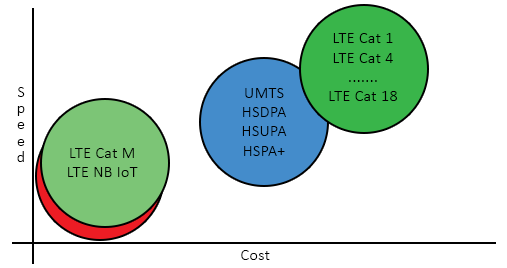To identify the ideal Industrial Cellular Modem for your application we have developed the Modem Selector Tool which is a configurable filter to narrow down the results to match your exact requirements.
LTE Category M is part of the LTE specification and has been designed to offer a low power solution with a low data rate which is ideal for IoT solutions. The specification was introduced in 2016 and is scheduled for 3GPP release 13. Part of the 5G specification includes enhanced machine type communication (eMTC) which will link to the NB IoT and category M LTE standards and form the basis for the future MTC of the 5G network.
The specificaton also defines orthogonal frequency-division multiplexing (OFDM) for connection uplink and single carrier frequency division multiplex (SC-FDMA) connection downlink and the bandwidth is limited to 1.4Mbit/s.
There are several significant advantages of category M.
- It offers enhanced power savings which means that devices can run for extended periods of time on battery. This is due to improved deep sleep states called power saving modes (PSM) and periodic wakeup states called extened discontinuous reception (eDRX).
- It supports a large number of connections as it has been designed for small bursts of data with a narrow bandwidth.
- As LTE category M utilizes a narrowband standard it means that it has substantially improved network coverage over LTE class 4, which is especially advantageous in buildings and carparks and underground.
- LTE category M devices are much lower cost than full LTE category 4 and higher devices due to the fact that they have narrow bandwidth and operate using a half duplex connection strategy.
- The operating costs of running an LTE category M network are lower due to the fact that the network performance is similar to that of the original 2G network with low data rates and lower amounts of transferred data.

LTE category M is compatible with the existing LTE infrastructure but it requires a software update to be applied by the network to enable the category M services. This software update is planned for release 13 and will be rolled out over the next few years in each region.
As LTE category M is compatible with the existing LTE infrastructure the network operators have to provide a very low investment to support category M functionality within their networks and as a result the uptake of category M accross the globe is gaining momentum.
This table shows the defined LTE narrowband categories.
| LTE Cat 1 | LTE Cat 0 | LTE Cat M1 (eMTC) | LTE Cat NB1 (NB-IoT) | EC-GSM-IoT | |
| 3GPP Release | Release 8 | Release 12 | Release 13 | Release 13 | Release 13 |
| Downlink Peak Rate | 10 Mbit/s | 1 Mbit/s | 1 Mbit/s | 250 kbit/s | 474 kbit/s (EDGE) |
| 2 Mbit/s (EGPRS2B) | |||||
| Uplink Peak Rate | 5 Mbit/s | 1 Mbit/s | 1 Mbit/s | 250 kbit/s (multi-tone) | 474 kbit/s (EDGE) |
| 20 kbit/s (single-tone) | 2 Mbit/s (EGPRS2B) | ||||
| Latency | 50–100ms | not deployed | 10ms–15ms | 1.6s–10s | 700ms–2s |
| Number of Antennas | 2 | 1 | 1 | 1 | 1–2 |
| Duplex Mode | Full Duplex | Full or Half Duplex | Full or Half Duplex | Half Duplex | Half Duplex |
| Device Receive Bandwidth | 1.4 – 20 MHz | 1.4 – 20 MHz | 1.4 MHz | 180 kHz | 200 kHz |
| Receiver Chains | 2 (MIMO) | 1 (SISO) | 1 (SISO) | 1 (SISO) | 1–2 |
| Device Transmit Power | 23 dBm | 23 dBm | 20 / 23 dBm | 20 / 23 dBm | 23 / 33 dBm |
LTE network split by LTE category and associated application examples.
| 1 Gbit/s | LTECat 4 | Aggregators / Distribution | ||
| 100 Mbit/s | Video Surveillance | Internet Hotspots | Infotainment | |
| 20 Mbit/s | IoT Gateways | Network Bridges | Server Backup | |
| 10 Mbit/s | LTECat 1 | Data Devices / Services | ||
| 5 Mbit/s | Digital Signage | Retail Kiosks | ATM | |
| 2 Mbit/s | Healthcare | Alarm Panels | POS Terminals | |
| 1 Mbit/s | LTECat M | Wearables / Meters | ||
| 250 Kbit/s | Personal Tracking | ANPR Monitoring | Telematics | |
| 100 Kbit/s | Smart Watches | Asset Tracking | AMR | |
| 10 Kbit/s | LTENB IoT | Sensors / Tagging | ||
| 5 Kbit/s | HVAC Control | Lighting | Pollution Moitoring | |
| 1 Kbit/s | Smoke Detectors | Livestock Tagging | Agriculture Monitoring | |
